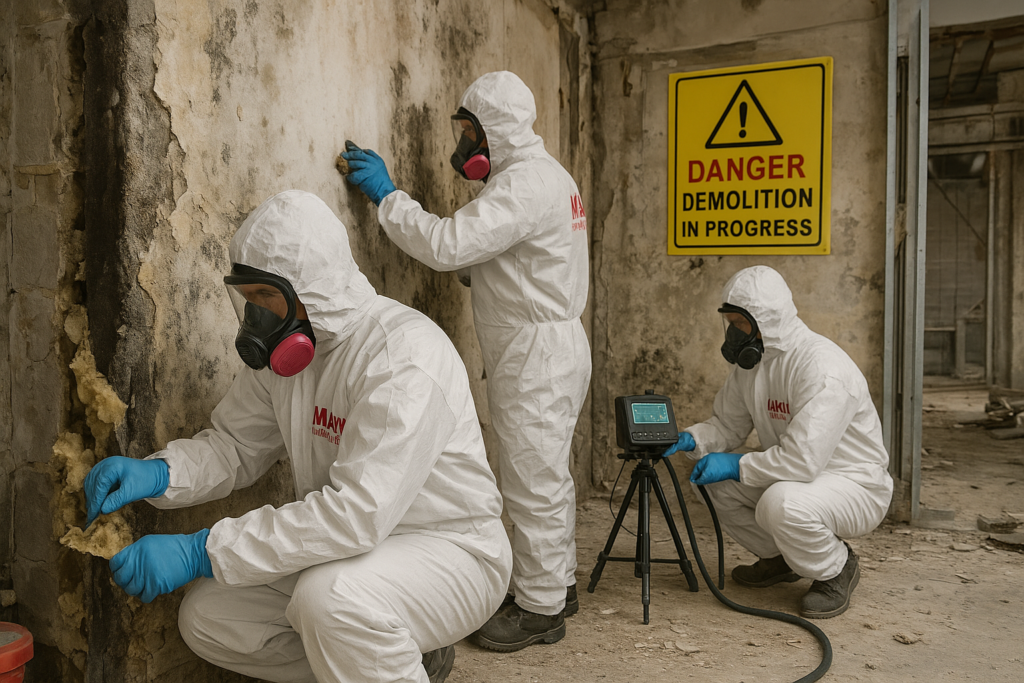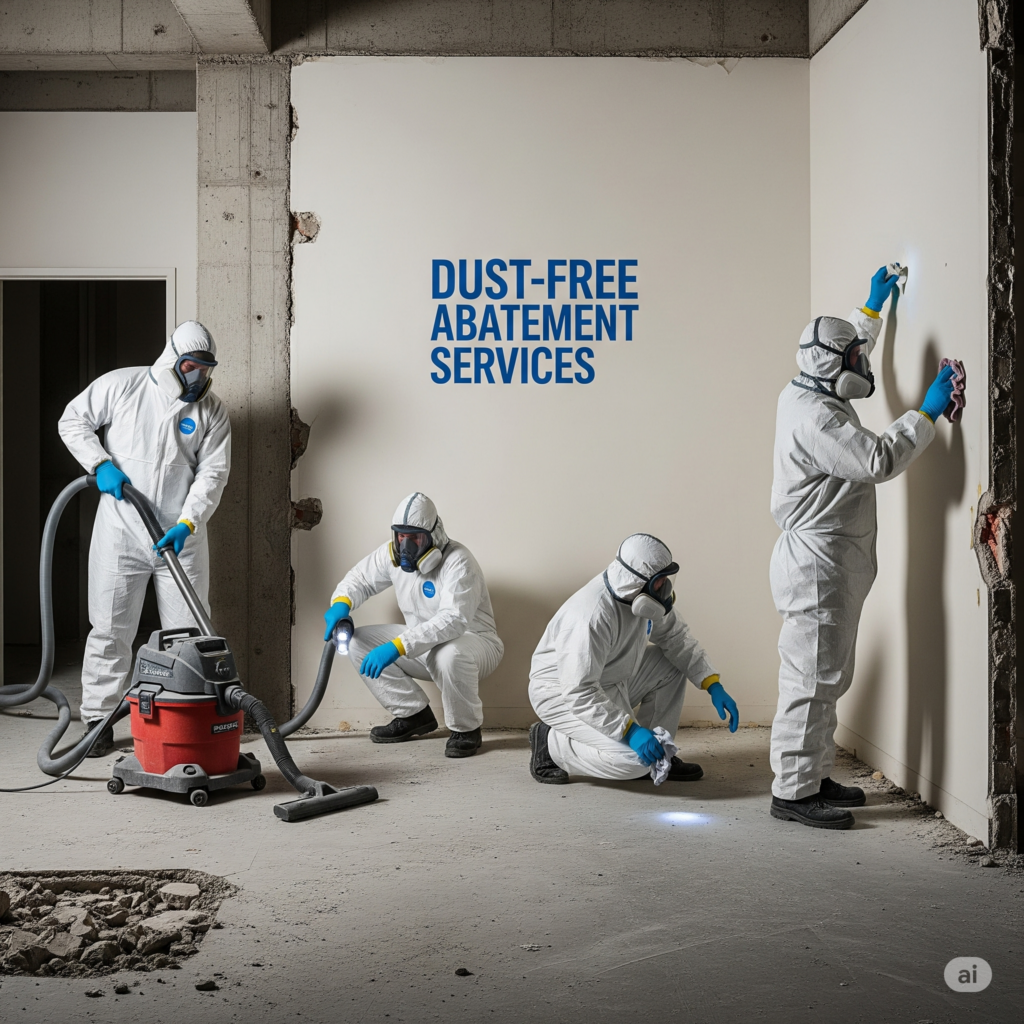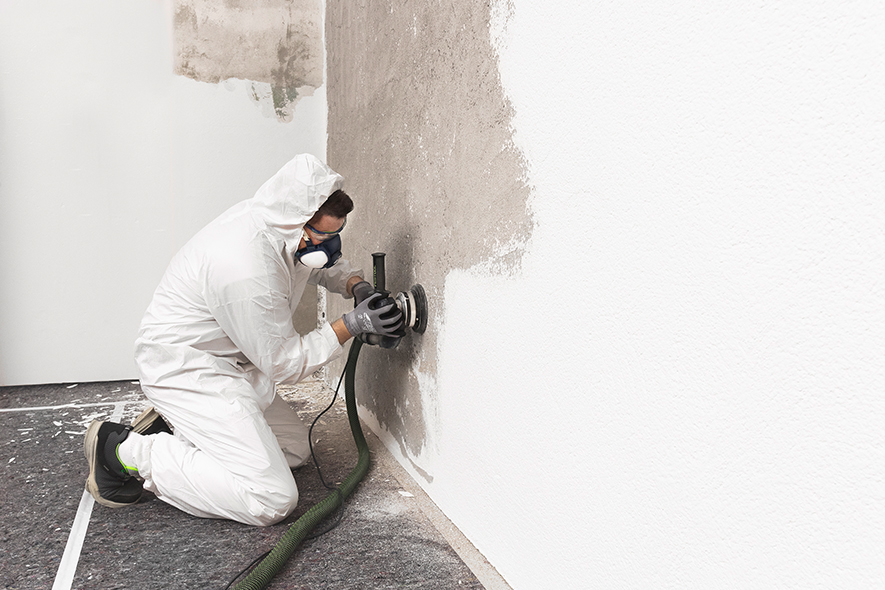Abatement Services in Calgary
Makki Demolition & Abatement for Residential & Commercial Needs




At Makki Demolition & Abatement, we are proud to be one of the leading providers of asbestos removal and abatement services in Calgary and the surrounding area. We specialize in mould abatement, providing comprehensive solutions to eliminate mould and prevent future growth. we provide Calgary asbestos removal and certified hazardous material abatement services. Our team ensures safety and compliance for every project, protecting your home or business from asbestos exposure. Safety, compliance, and environmental responsibility are at the core of everything we do. Our certified team specializes in asbestos removal , Mould Remediation , and Hazardous Materials Testing & Verification to ensure your property is safe, healthy, and fully prepared for demolition, renovation, or redevelopment. We work with Calgary homeowners, contractors, and developers to deliver professional abatement solutions for residential, commercial, and industrial projects.
At Makki Demolition & Abatement, we follow strict Alberta asbestos safety regulations. You can read more about Alberta’s asbestos guidelines and Health Canada’s recommendations for safe asbestos removal.
Trusted Asbestos, Mold & Hazardous Material Removal Experts
Makki Demolition & Abatement provides professional asbestos abatement in Calgary for residential, commercial, and industrial properties. Our certified team specializes in asbestos removal, mold remediation, lead abatement, and hazardous material disposal, ensuring your property is safe and compliant with Alberta regulations.
Asbestos Abatement in Calgary
Asbestos is a serious health hazard if disturbed or improperly removed. Our licensed professionals provide Calgary asbestos removal services following strict containment, removal, and disposal procedures. Our licensed professionals provide Calgary asbestos abatement services following strict containment, removal, and disposal procedures. By preventing harmful fibers from spreading and ensuring compliance with Alberta’s environmental and occupational health regulations, we protect your building, its occupants, and your peace of mind.
Calgary Mould Remediation Services
Mould growth can cause structural damage and pose serious health risks. At Makki Demolition, our experts deliver Calgary mould remediation services designed to identify the source of moisture, remove contaminated materials, and restore clean indoor air quality. With advanced remediation techniques, we ensure long-term results and protect the safety of your property and its occupants.
Calgary Hazardous Materials Testing & Verification
Every project includes hazardous materials testing in Calgary both before and after remediation. This step ensures accurate detection of asbestos, mould, and other contaminants, while verifying that removal has been successfully completed. We provide detailed reports that meet both client needs and regulatory requirements.
Why Choose Makki Demolition & Abatement for Asbestos Abatement in Calgary?
Certified and insured abatement specialists with extensive local experience.
Strict adherence to Alberta safety standards and environmental regulations.
Trusted by Calgary homeowners, contractors, and property managers.
Full-service solutions for demolition, abatement, and remediation projects.
Commitment to safety, precision, and efficiency on every job.
Whether you are planning a demolition, renovation, or restoration project in Calgary, Makki Demolition & Abatement is your trusted partner for safe, reliable, and cost-effective abatement solutions. From certified asbestos abatement Calgary to Calgary mould remediation Services, we help create healthier spaces and ensure your property is ready for its next stage of development.
Asbestos Abatement Services in Calgary
Safe & Reliable Abatement Services
Abatement testing
At Makki Demolition, we provide professional abatement testing services to identify and assess hazardous materials such as asbestos, mould, and lead before any demolition or renovation project begins. Accurate testing ensures a safe environment for workers, occupants, and surrounding areas.
Our certified team uses advanced equipment and procedures to detect harmful substances, verify air quality, and confirm that abatement has been completed effectively. With safety and compliance as our top priorities, we deliver reliable testing that protects people, property, and the environment.
Whether for residential homes or large commercial buildings, Makki Demolition offers trusted abatement testing services that give our clients peace of mind and confidence in every project.
Asbestos Abatement
Specializing in asbestos abatement, Makki Demolition follows strict industry standards and proven safety practices to remove hazardous asbestos materials from residential, commercial, and industrial buildings. Our trained professionals use advanced containment methods and equipment to ensure fibers are not released into the air, protecting both workers and occupants.
With a focus on compliance, precision, and environmental responsibility, we handle every stage of the Calgary Asbestos Abatement Process—from inspection and removal to safe disposal. Whether it’s a small renovation or a large-scale demolition project, Makki Demolition delivers safe, efficient, and certified asbestos abatement services that minimize risk and provide peace of mind.
Mould Abatement
Excelling in mould abatement and remediation, Makki Demolition provides a specialized approach to identify, contain, and safely remove mould from residential, commercial, and industrial spaces. Our process addresses not only the visible growth but also the underlying causes, such as moisture and ventilation issues, to ensure long-term results.
Our experienced team uses precision tools, protective equipment, and proven remediation techniques to target only the affected areas, minimizing disruption to the rest of the structure. Whether it involves removing contaminated materials, cleaning surfaces, or restoring air quality, we guarantee safe and efficient mould abatement that preserves building integrity while protecting the health of occupants.
Comprehensive Abatement Services
- Mold Abatement & Remediation – Prevent cross-contamination with industry-grade containment.
- Lead Abatement – Safe removal of lead-based paints and coatings.
- Hazardous Material Removal – Including vermiculite, drywall, flooring, and insulation.
- Commercial & Industrial Abatement – Large-scale projects for offices, schools, and warehouses.
- Selective Interior Demolition – Removing contaminated sections without damaging structures.
Large-Scale Abatement
At Makki Demolition, our dust-free abatement services in Calgary are specifically designed to provide safe, efficient, and environmentally responsible hazardous material removal. We understand that asbestos, mould, and lead can pose serious risks to both health and property, which is why our team follows strict safety protocols and industry regulations to ensure every project is completed with the highest level of precision and care.
Our certified technicians are highly trained in asbestos abatement, mould remediation, and lead removal, using advanced containment systems, HEPA-filtered negative air units, and specialized tools to minimize airborne contamination. By controlling dust and preventing the spread of hazardous particles, we not only protect workers and occupants but also safeguard the surrounding environment from harmful exposure.
We provide dust-free abatement solutions for residential homes, commercial properties, and industrial facilities across Calgary and Alberta. Whether it’s part of a demolition, renovation, or restoration project, our approach ensures a clean, controlled process that eliminates health hazards while maintaining compliance with Alberta Occupational Health & Safety and environmental regulations.
At Makki Demolition, we don’t just remove hazardous materials — we deliver peace of mind. From initial site assessment and testing, through containment and removal, to final inspection and verification, we manage the entire Calgary Asbestos Abatement Process with transparency, safety, and efficiency. Our goal is to leave every site clean, safe, and ready for its next stage of development.
When it comes to dust-free abatement in Calgary, trust Makki Demolition to get the job done right — protecting your property, your people, and your peace of mind.

Eco-Friendly Abatement Services, Waste Management & Recycling
Our commitment to eco-friendly waste management and recycling is a core part of Makki Demolition and abatement’s dust-free concrete demolition services. We prioritize the responsible disposal and repurposing of materials, ensuring that concrete, metal, and other debris are recycled whenever possible.
By working with certified recycling facilities and following best practices, we significantly reduce landfill use and help conserve natural resources. This strong focus on sustainability not only lessens our environmental footprint but also contributes to a circular economy, making us a smart, responsible choice for your next project.
Our Structured Approach to Abatement Projects
Comprehensive Assessment & Planning
Every abatement project with Makki Demolition & Abatement starts with a detailed inspection of your property. Our certified Calgary abatement specialists carefully identify asbestos-containing materials, mould growth, or lead hazards that may put your building and its occupants at risk. Once hazards are identified, Makki Abatement develops a customized abatement plan outlining containment measures, removal methods, project timelines, and compliance requirements. By tailoring our strategy to each site, we ensure that our Calgary abatement services are safe, efficient, and fully aligned with Alberta’s strict environmental and occupational health regulations.
Safe Containment & Hazard Removal
At Makki Demolition & Abatement, safety is never compromised. Our Calgary abatement team uses advanced containment systems, negative air pressure units, and HEPA-filtered tools to isolate affected areas and prevent contamination. Whether it’s asbestos abatement in Calgary homes, mould remediation in commercial buildings, or lead removal in industrial facilities, our technicians follow strict industry standards to guarantee safe and effective removal. By choosing Makki Abatement’s dust-free abatement services, clients can trust that hazardous materials are eliminated without spreading harmful particles—protecting workers, residents, and the surrounding environment.
Verification, Documentation & Project Completion
Makki Demolition & Abatement ensures that every Calgary abatement project is completed with full transparency and accountability. After removal, we perform rigorous air quality testing and clearance verification to confirm the space is safe and hazard-free. Our clients receive detailed reports documenting the Calgary Asbestos Abatement Process, which are essential for regulatory compliance and peace of mind. Once testing is complete, Makki Demolition & Abatement leaves the property clean, secure, and ready for its next phase—whether that’s demolition, renovation, or occupancy. With Makki Demolition & Abatement, you can be confident that your abatement project is handled with professionalism from start to finish.
Why Choose Makki Demolition & Abatement?





Licensed & Insured Abatement Experts
When you choose Makki Demolition & Abatement, you’re partnering with fully licensed and insured professionals who specialize in Abatement Services in Calgary such as asbestos abatement, mould remediation, abatement testing and hazardous material removal in Calgary. Safety and compliance are at the core of everything we do, and our team follows strict environmental and occupational health standards to protect both people and property.
With years of hands-on experience, Makki Demolition & Abatement ensures that every abatement project is executed with precision and in full compliance with Alberta regulations. Backed by comprehensive insurance and proper certification, you can feel confident knowing that your abatement project is being handled by trusted Calgary specialists. Our commitment to high standards makes Makki Demolition & Abatement the dependable choice for safe and effective hazardous material removal.
Efficient Abatement Project Management
At Makki Demolition & Abatement, efficiency and precision define our approach to abatement projects in Calgary. From the initial site assessment and hazard identification to containment, removal, and verification, our structured process ensures that every step is handled with care.
We deliver abatement projects on time, within budget, and with minimal disruption—whether for a residential home, commercial property, or industrial facility. With extensive experience in asbestos abatement, mould remediation, abatement testing and lead removal, Makki Demolition & Abatement provides cost-effective solutions that prioritize safety and compliance, giving clients complete peace of mind throughout the project.
Client-Focused Abatement Services
What truly sets Makki Demolition & Abatement apart is our client-first approach. We believe that every abatement project should be transparent, collaborative, and stress-free. From your initial consultation to final clearance testing, our team keeps you informed and involved at every stage.
We take the time to understand your needs, respond quickly to questions, and deliver solutions that align with your goals and safety requirements. This dedication to building strong relationships ensures that when you choose Makki Demolition & Abatement in Calgary, you receive not only safe and compliant results, but also a smooth and reliable client experience from start to finish.
Get Started with Professional Abatement Services Today at Makki Demolition & Abatement
If you are ready to transform your space, Makki Demolition & Abatement offers a straightforward process from initial consultation to project completion. For demolition projects in Calgary, our approach begins with a comprehensive site assessment to identify your specific needs and potential challenges. We then provide a transparent, no-obligation quote tailored to your project. Once approved, our licensed and insured team manages every aspect of the demolition with precision—ensuring safety, efficiency, and minimal disruption to your property.
When it comes to abatement services in Calgary, Makki provides the same structured and reliable process. Whether you require asbestos abatement, mould remediation, and abatement testing, our specialists use advanced dust-free containment systems and follow strict regulatory standards to protect your property, occupants, and the environment. From hazard testing to removal and final clearance verification, we deliver abatement solutions that give you confidence and peace of mind.
For more information about our residential, commercial, or industrial demolition services or to book an appointment, call Makki Demolition & Abatement at +1 (403) 392-2803 or contact us here.
Makki Demolition & Abatement – Certified Asbestos Abatement in Calgary
Makki Demolition & Abatement provides certified asbestos abatement in Calgary, ensuring safe and compliant removal of hazardous materials. We provide certified asbestos abatement services in Calgary and Southern Alberta, available 24/7/365 for both planned projects and Emergency Asbestos Removal in Calgary. Our team is fully trained and licensed to handle Type 1, Type 2, and Type 3 asbestos abatement, ensuring your property is safe, compliant, and free from hazardous materials.
At Makki Demolition & Abatement, we strictly follow all Alberta Occupational Health and Safety asbestos requirements and the Canadian federal asbestos regulations. Our certified team ensures that every project meets or exceeds provincial and federal safety standards for asbestos handling and removal.
Type 1, Type 2 & Type 3 Asbestos Abatement
Different asbestos situations require different solutions. Our experts specialize in:
-
Type 1 abatement – Low-risk removal with minimal disturbance.
-
Type 2 abatement – Moderate-risk removal requiring containment measures.
-
Type 3 abatement – High-risk asbestos abatement with full containment and advanced safety procedures.
Whether residential or commercial, we have the right solution for every scenario.
24/7 Emergency Asbestos Removal
Asbestos exposure is a serious health risk. That’s why we offer 24/7 emergency asbestos abatement services in Calgary. Our certified team responds quickly to assess, contain, and safely remove asbestos to protect your health and property.
Asbestos Testing, Air Quality & Surveys
We go beyond removal by offering:
-
Asbestos testing to confirm the presence of hazardous materials
-
Material surveys for a full risk assessment
-
Air quality testing to ensure your environment meets Alberta safety standards
-
Health and safety consulting to guide you every step of the way
Certified & Compliant Abatement Services
Every project is handled by licensed asbestos abatement contractors, following Alberta OHS regulations and City of Calgary compliance standards. We guarantee:
-
Safe removal and disposal of asbestos-containing materials
-
Environmentally responsible remediation
-
Certified professionals with years of experience
Why Choose Makki Demolition & Abatement?
-
✅ Local Calgary experts
-
✅ Certified asbestos abatement contractors
-
✅ Available 24/7 for emergencies
-
✅ Free estimates and on-site assessments
-
✅ Trusted by homeowners and businesses across Southern Alberta
📞 Call Makki Demolition & Abatement today for certified asbestos abatement in Calgary.
Whether it’s a scheduled project or an emergency, our team is here 24/7 to keep your property safe.
Frequently Asked Questions (FAQ)
What is Type 1, 2, and 3 asbestos abatement?
Type 1 involves low-risk removal, Type 2 is moderate-risk, and Type 3 covers high-risk abatement that requires full containment and strict safety procedures.
Do you provide emergency asbestos removal in Calgary?
Yes! We are available 24/7/365 to respond to urgent asbestos abatement needs.
Are your services compliant with Alberta safety laws?
Absolutely. All our work follows Alberta OHS regulations and City of Calgary requirements, giving you peace of mind.
Check Customers Reviews







